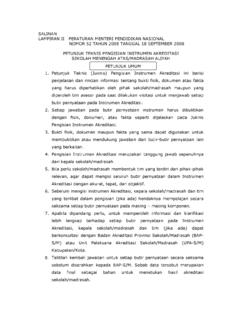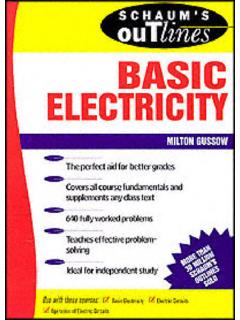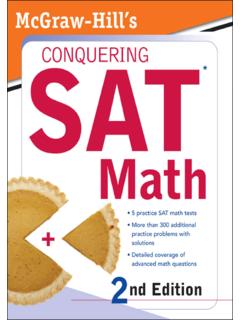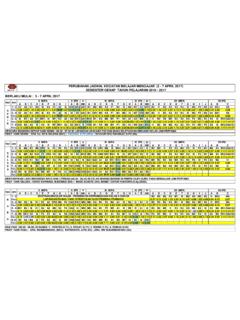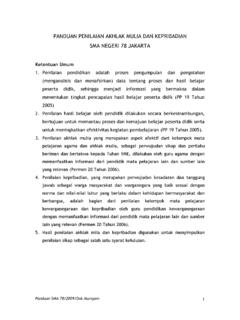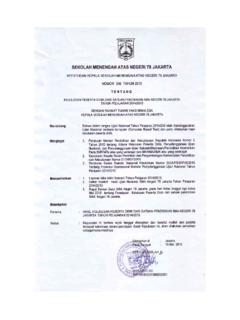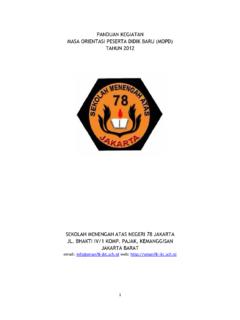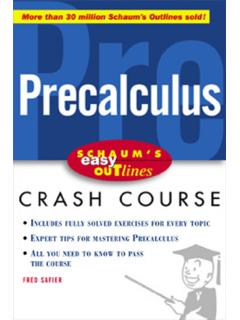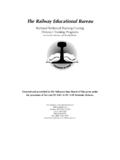Transcription of FIVE STEPS TO A - Situs Resmi SMA Negeri 78 Jakarta
1 five STEPS TO A5AP StatisticsOther books in McGraw-Hill s 5 STEPS to a 5series include:AP BiologyAP Calculus AB/BCAP ChemistryAP Computer ScienceAP English LanguageAP English LiteratureAP European HistoryAP Microeconomics/MacroeconomicsAP Physics B and CAP PsychologyAP Spanish LanguageAP Government and PoliticsAP HistoryAP World History11 Practice Tests for the AP ExamsWriting the AP English EssayFIVESTEPSTOA5AP StatisticsDuane C. Hinders2008 2009 MCGRAW-HILLNew York Chicago San Francisco Lisbon London MadridMexico City Milan New Delhi San Juan Seoul Singapore Sydney TorontoCopyright 2008, 2004 by The McGraw-Hill Companies, Inc. All rights reserved. Manufactured in the United States of America.
2 Except as permittedunder the United States Copyright Act of 1976, no part of this publication may be reproduced or distributed in any form or by any means, or stored in adatabase or retrieval system, without the prior written permission of the publisher. 0-07-159466-3 The material in this eBook also appears in the print version of this title: trademarks are trademarks of their respective owners. Rather than put a trademark symbol after every occurrence of a trademarked name, we use namesin an editorial fashion only, and to the benefit of the trademark owner, with no intention of infringement of the trademark. Where such designations appearin this book, they have been printed with initial caps. McGraw-Hill eBooks are available at special quantity discounts to use as premiums and sales promotions, or for use in corporate training programs.
3 Formore information, please contact George Hoare, Special Sales, at or (212) 904-4069. TERMS OF USE This is a copyrighted work and The McGraw-Hill Companies, Inc. ( McGraw-Hill ) and its licensors reserve all rights in and to the work. Use of thiswork is subject to these terms. Except as permitted under the Copyright Act of 1976 and the right to store and retrieve one copy of the work, you may notdecompile, disassemble, reverse engineer, reproduce, modify, create derivative works based upon, transmit, distribute, disseminate, sell, publish or subli-cense the work or any part of it without McGraw-Hill s prior consent. You may use the work for your own noncommercial and personal use; any otheruse of the work is strictly prohibited.
4 Your right to use the work may be terminated if you fail to comply with these terms. THE WORK IS PROVIDED AS IS. McGRAW-HILL AND ITS LICENSORS MAKE NO GUARANTEES OR WARRANTIES AS TO THE ACCURACY, ADEQUACY OR COMPLETENESS OF OR RESULTS TO BE OBTAINED FROM USING THE WORK, INCLUDING ANY INFORMATION THAT CAN BE ACCESSED THROUGH THE WORK VIA HYPERLINK OR OTHERWISE, AND EXPRESSLY DISCLAIM ANYWARRANTY, EXPRESS OR IMPLIED, INCLUDING BUT NOT LIMITED TO IMPLIED WARRANTIES OF MERCHANTABILITY OR FITNESSFOR A PARTICULAR PURPOSE. McGraw-Hill and its licensors do not warrant or guarantee that the functions contained in the work will meet yourrequirements or that its operation will be uninterrupted or error free.
5 Neither McGraw-Hill nor its licensors shall be liable to you or anyone else for anyinaccuracy, error or omission, regardless of cause, in the work or for any damages resulting therefrom. McGraw-Hill has no responsibility for the contentof any information accessed through the work. Under no circumstances shall McGraw-Hill and/or its licensors be liable for any indirect, incidental, special, punitive, consequential or similar damages that result from the use of or inability to use the work, even if any of them has been advised of thepossibility of such damages. This limitation of liability shall apply to any claim or cause whatsoever whether such claim or cause arises in contract, tortor otherwise.
6 DOI: hope you enjoy thisMcGraw-Hill eBook! Ifyou d like more information about this book,its author, or related books and websites,please click to learn more?CONTENTSP reface, ixAcknowledgments, xiAbout the Author, xiiIntroduction: The five - step Program, xiiiThe Basics, xiiiSTEP 1 Set Up Your Study Program, 11 What You Need to Know About the AP Statistics Exam,3 Background Information, 3 Some Frequently Asked Questions About the AP Statistics Exam, 42 How to Plan Your Time,10 Three Approaches to Preparing for the AP Statistics Exam, 10 Calendar for Each Plan, 12 step 2 Determine Your Test Readiness, 153 Take a Diagnostic Exam,17AP Statistics Diagnostic Test, 19 Answers and Explanations, 29 Interpretation: How Ready Are You?
7 38 step 3 Develop Strategies for Success, 394 Tips for Taking the Exam,41 General Test-Taking Tips, 42 Tips for Multiple-Choice Questions, 42 Tips for Free-Response Questions, 43 Specific Statistics Content Tips, 45 step 4 Review the Knowledge You Need to Score High, 475 Overview of Statistics/Basic Vocabulary,49 Quantitative versus Qualitative Data, 50 Descriptive versus Inferential Statistics, 50 Collecting Data: Surveys, Experiments, Observational Studies, 51 Random Variables, 526 One-Variable Data Analysis,55 Graphical Analysis, 56 Measures of Center, 62 Measures of Spread, 64 Position of a Term in a Distribution, 67 Normal Distribution, 70 For more information about this title, click here7 Two-Variable Data Analysis,87 Scatterplots, 87 Correlation, 89 Lines of Best Fit, 93 Residuals, 96 Coefficient of Determination, 98 Outliers and Influential Observations, 99 Transformations to Achieve Linearity, 1008 Design of a Study.
8 Sampling, Surveys, and Experiments, 113 Samples, 114 Sampling Bias, 116 Experiments and Observational Studies, 1189 Random Variables and Probability, 134 Probability, 134 Random Variables, 139 Normal Probabilities, 143 Simulation and Random Number Generation, 145 Transforming and Combining Random Variables, 148 Rules for the Mean and Standard Deviation of Combined Random Variables, 14810 Binomial Distributions, Geometric Distributions, and Sampling Distributions, 162 Binomial Distributions, 162 Normal Approximation to the Binomial, 165 Geometric Distributions, 167 Sampling Distributions, 168 Sampling Distributions of a Sample Proportion, 17211 Confidence Intervals and Introduction to Inference, 185 Estimation and Confidence Intervals, 186 Confidence Intervals for Means and Proportions, 189 Sample Size, 194 Statistical Significance and P-value, 196 The Hypothesis-Testing Procedure, 198 Type-I and Type-II Errors and the Power of a Test, 19912 Inference for Means and Proportions, 215 Significance Testing, 216 Inference for a Single Population Mean, 218 Inference for the Difference Between Two Population Means, 221 Inference for a Single Population Proportion, 223 Inference for the Difference Between Two Population Proportions, 22513 Inference for Regression, 243 Simple Linear Regression, 243 Inference for the Slope of a Regression Line.
9 245 Confidence Interval for the Slope of a Regression Line, 247 Inference for Regression Using Technology, 249vi Contents14 Inference for Categorical Data: Chi-square, 263 Chi-square Goodness-of-Fit Test, 263 Inference for Two-Way Tables, 268 step 5 Build Your Test-Taking Confidence, 285AP Statistics Practice Exam 1, 289AP Statistics Practice Exam 2, 319 Appendices, 333 Formulas, 334 Tables, 336 Bibliography, 340 Web sites, 341 Glossary, 342 Contents viiThis page intentionally left blank PREFACEC ongratulations, you are now an AP Statistics student. AP Statistics is one of the mostinteresting and useful subjects you will study in school. Sometimes it has the reputation ofbeing easy compared to calculus.
10 However, it can be deceptively difficult, especially in thesecond half. It is different and challenging in its own way. Unlike calculus, where you areexpected to get precise answers, in statistics you are expected to learn to become comfort-able with uncertainly. Instead of saying things like, The answer you will more oftenfind yourself saying things like, We are confident or We have evidence It sa new and exciting way of do you do well on the AP Exam (by well, I mean a 4 or a 5 although most stu-dents consider 3 or better to be passing)? By reading this book; by staying on top of thematerial during your AP Statistics class; by studying when it is time to study. Note that thequestions on the AP Exam are only partially computational they also involve thinkingabout the process you are involved in and communicating your thoughts clearly to theperson reading your exam.
